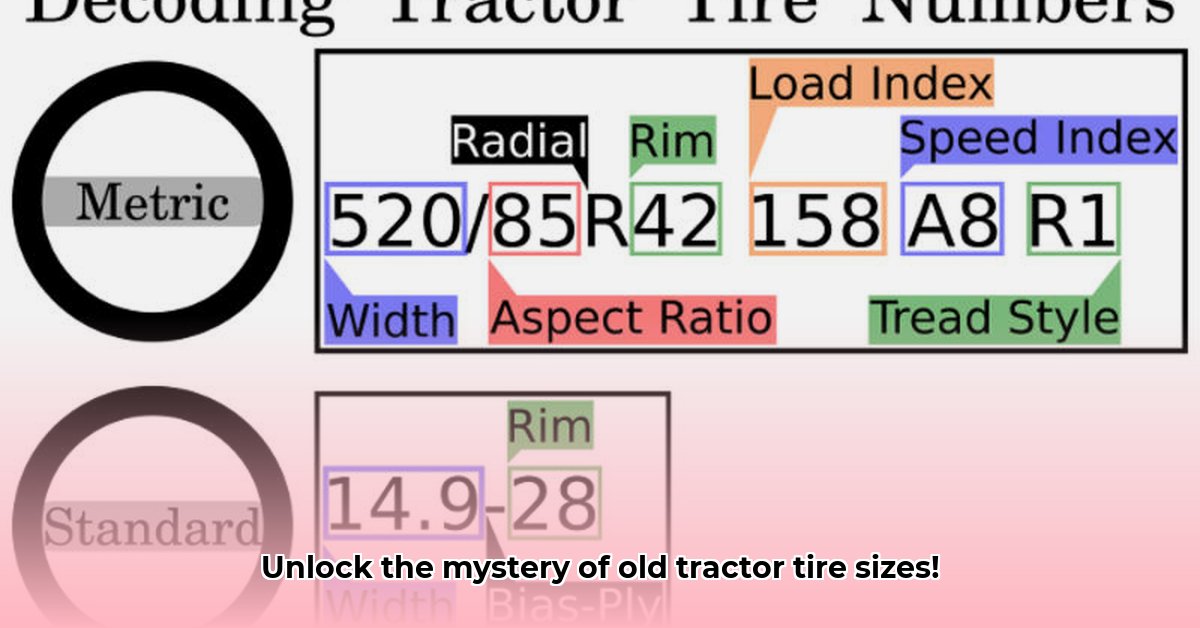
Finding replacement tires for your antique tractor can feel like navigating a historical minefield. Inconsistent sizing practices from the past mean simple number conversions often fall short. This guide provides a practical approach, blending historical context with clear instructions to help you find the right modern equivalents for your classic machine. We'll explore the evolution of tire sizing, offer conversion charts, address critical considerations for safe operation, and provide resources to help you succeed. For more specialized tire information, check out this helpful resource on 12-4 tractor tires.
A Century of Change: The Evolution of Tractor Tire Sizing
Early tractor tire sizing lacked the standardization we see today. Manufacturers used varied measurement systems, resulting in a confusing array of sizes, some with incomplete documentation. This historical inconsistency makes finding modern equivalents challenging, requiring careful research and verification. The transition to modern standardization was gradual and uneven, with many gaps in historical records that make precise conversions difficult. Understanding this historical context is crucial for navigating the complexities of old tractor tire sizes. Do you know how many different systems were used before standardization? The sheer number of historical methods and variances might surprise you.
Deciphering the Numbers: Conversion Charts and Practical Considerations
While conversion charts exist, they aren't always entirely accurate due to the aforementioned historical inconsistencies and variations between manufacturers. Cross-referencing multiple sources is essential for reliable results. The following table provides approximate equivalents; always verify with additional sources before purchasing.
| Old Size | Modern Equivalent (Approximate) | Rim Size (inches) | Notes |
|---|---|---|---|
| 6-16 | 7.50-16 | 6 | Commonly available replacement. |
| 8-32 | 11.2-32 | 8 | Verify rim compatibility; may require careful sourcing. |
| 11-28 | 13.6-28 | 11.25 | Difficult to find; consider custom ordering or alternatives. |
| 12-24 | 14.9-24 | 12 | Pay close attention to load rating; radial options often available. |
| 14-28 | 16.9-28 | 14 | Commonly available, but verify load rating for your tractor's weight. |
Important Note: The above table offers likely equivalents, but it's crucial to cross-reference this information with other sources and consult a specialist before purchasing tires. Tire sizes can vary due to manufacturing tolerances and brand differences.
Beyond the Numbers: Essential Factors for Safe Operation
Accurate conversion is only the first step; several other factors are paramount for safe operation.
Rim Compatibility: The new tire must fit your rim perfectly. Improper fit can lead to dangerous blowouts or other malfunctions. Precise measurement of your existing rim is crucial before ordering replacements. A mismatch can compromise safety and handling.
Tread Types: Different tread patterns (R-1, R-2, R-3, and others) serve different purposes. R-1 treads are common all-purpose treads providing balanced performance. R-2 is often preferred for aggressive field work, offering better traction in challenging conditions. Selecting the right tread type ensures optimal traction and performance for your specific use cases, whether for road travel or field work.
Sourcing Replacements: Finding the correct tire may necessitate thorough research. Start with your local farm equipment dealer, then explore online resources for antique tractor parts and tires. Specialist suppliers catering to vintage equipment offer access to harder-to-find sizes. Consider exploring online forums dedicated to vintage tractors. Such communities often have members with similar experiences and suggestions for sourcing parts. Custom-made tires may be necessary in some cases, especially for unique or uncommon sizes, which often represents a premium-priced solution.
Load Capacity: The tire's load capacity must meet or exceed your tractor's weight. Insufficient load capacity significantly increases the risk of dangerous tire failure. Always consult your tractor's manual and the tire manufacturer's specifications to ensure compatibility and safe operation. Using an under-rated tire can result in accidents and damage to your tractor.
Troubleshooting and Advanced Techniques
Finding exact matches can sometimes be impossible. The following approaches address challenging situations.
Adapting Modern Tires: Adapting modern tires to older rims can be possible, but this process is complex and risky, and should only be undertaken by experienced and qualified mechanics. Improper modification can lead to severe hazards. Such alterations should be deemed a last resort.
Custom-Made Tires: For incredibly uncommon sizes, custom-made tires represent a solution, though they're usually more expensive.
Exploring Close Alternatives: It might be possible to use tires slightly different from your original size, but carefully evaluate any potential impacts on speed, handling, and overall safety. Prioritize safety; minor dimension changes are acceptable only when they do not jeopardize structural integrity or operational performance.
Resources and Further Reading
Several resources can assist in your search:
Online Forums: Websites and forums dedicated to antique tractors are invaluable resources for connecting with experienced owners and finding valuable insights.
Specialty Suppliers: Agricultural supply stores specializing in older equipment or parts often hold less commonly available tire sizes.
Tractor Manuals: Your tractor's original manual should usually provide guidance on tire size recommendations and potential compatible replacements.
This comprehensive guide provides a solid framework for navigating the complexities of old tractor tire size conversion. Remember, safe operation is paramount; prioritize careful research and accurate selection to maintain the longevity and handling of your antique tractor.